

Wolff's Law:
Your body will respond to any stress or demand placed upon it.
Muscle will grow when asked to grow.
And there are 3 main ways to ask muscle to grow:

 Lift something heavy.
Lift something heavy.

 Lift something quickly.
Lift something quickly.

 Lift something for a long time.
Lift something for a long time.
This means if you gradually stress a muscle over time, it will respond by getting longer, stronger, or more powerful, depending on how you choose to stress it.

Now, let's discuss muscle building program design, so you can get started as soon as possible:
Growing muscle means you'll need to be committed to working out 2-5x every week, which can vary from one training phase to the next. For example, if you're doing a lot of plyometrics, it's a good idea to start out with 2 days per week and work your way up to 4.
Another great example of lower frequency in building muscle is when you're choosing 1-3 exercises and focusing on only them. This is considered the Minimum Effective Dose (MED) method of building muscle, and it looks something like this:
In this scenario, treat the three exercises as a giant set, meaning you'll go from doing cleans to bent leg deadlifts and then pull-ups without rest. Rest after each giant set, rather than after each exercise.
When MED Training, I suggest you only do the bottom 1/3rd of the exercise for 6-8 reps, and make sure to lift heavy enough to hit fatigue by your last rep. Repeat for a total of 4 sets, interrupted by 5 minutes rest. On your fifth and final set, go through the entire range of motion, rather than only the bottom 1/3rd.
Here's a bit more on program design -- by type of workout -- to help guide you:
In addition to resistance training with one of the methods above, it's a great idea to build sprinting into your workout schedule or periodization phases. Here are some parameters for sprinting, to give you a better idea:
Periodization means you'll take your overall goal, divide it into three phases, and strategically go about reaching it. Here's a practical example:

Main goal = Gain 14 pounds of muscle while losing 9 pounds of fat.
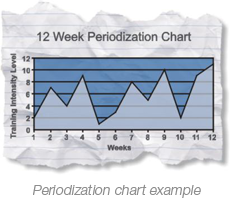
Now, this is an aggressive schedule to build muscle and lose fat at the same time. Keep in mind this is only for someone who is already balanced, safe, and ready for high intensity.
Generally speaking, you'll want to follow a muscle building schedule like this with an 'off' phase, where the focus shifts to tissue quality, instead of quantity. In a 'tissue quality' phase of building muscle, concerns like joint health, posture, muscle fiber type (slow or fast), stretching, cross-training, and performance become the priority.
Remember, every muscle building workout should be intense. On a scale of 0 to 10, where:
0 = no effort whatsoever
10 = passing out level of effort/fatigue
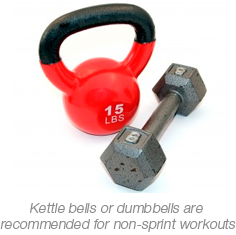
You'll want to be between 8.5-9.5 out of 10 during each set. In order to grow new muscle, you'll need to push your body and signal you're ready for growth. After all, we're talking about 25-45 minutes of your time, where at least half of it is spent resting. Make the most of every rep, of every set, of every workout.
For non sprint-based workouts, I recommend you use kettle bells or dumbbells, to your preference. Barbells can be useful, along with curling bars, and other modalities like sand bags, battle ropes, tires, cinderblocks, etc. However, I've noticed I get the same effect with a simple home gym, so I stick with kettle bells and dumbbells and rotate between the two.
When it comes to exercise sequencing -- or the order in which you stack exercises -- consider you're actually training your nerves, not your muscles. If the electricity to the muscle is fast and strong, then your muscle will contract, repair, and grow.
So, one nerve at a time, let's figure out the muscles that correlate. Then, simply choose exercises along those nerve tracts.

Example for the lower body:
Based upon the information above, we choose exercises that work the hamstrings, calves, and foot flexors on the same day, and in this order. This way, we are strengthening the nerve signal, from the spine-outward. This might be 'Workout A.'
'Workout B' -- which can be alternated with Workout A -- will have an emphasis on the femoral nerve. And we'll do the same thing for the upper body, trunk, and back.
With this simple strategy of 'training a nerve, not a muscle,' we can clearly make sense of which muscles and exercises to pair together and why.
Now, the key is to stack exercises together in such a way you can easily change your emphasis, but keep the same basic program design or formatting. Here's a better look at how this works:
By choosing 5 basic exercise categories, we can organize a muscle building workout into a simple-to-follow format:

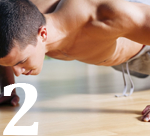
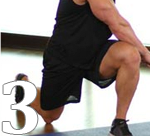
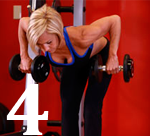

On Workout A, you might lead with Squat and Push, while Workout B might lead with Lunge and Pull. This way, you choose 2 exercise categories to emphasize muscle growth; the other categories can be left off, used for muscular endurance, muscle balancing, or practice for tomorrow's workout.
Above all else, always improve; progress every exercise over time.

If you're doing front squats with 25 pound kettlebells right now, work your way up to 50 pound kettlebells and overhead squats over time. Then, add jump squats to your routine and burn out after you drop the weights. There's always an ability to add a level of difficulty to an exercise -- or set of exercises -- and progress over time.
The most common mistakes we see people make with muscle building exercises are:
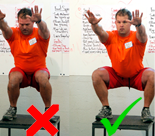 Form
Form
 Intensity
Intensity
 Rest
Rest
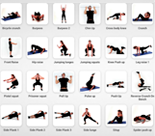 Exercise
Exercise Last, but not least, you grow what you eat.

If you want to grow muscle, you're going to need to eat. Without providing your body with extra food, it won't have the energy stores and resources to build muscle and support it over time. So, eat as if you were the size you want to be.
For example: If you're 170 pounds and 15% body fat, you might make it your goal to get to 175 pounds and 10% body fat. This would involve losing about 9 pounds of fat and gaining 14 pounds of muscle.

So, eat as if you already have this 14 pounds of muscle; then, pair your diet with workouts to get you there.
If you eat healthy foods -- selected specifically because they are naturally occurring and agree with your body -- you will fuel your body with the clean energy it takes to build healthy, strong, and athletic muscle.
On the other hand, if you eat junk, spike your calories, and alternate getting 'fat and strong' with 'fat loss' -- to eventually get a physique -- your outsides may fool others into thinking you're healthy. Purely manipulating calories and program design is one way to build muscle, but it's like getting a carwash on a car with a broken transmission. That car's lifetime is short, no matter how pretty it looks.

Don't make the mistake of choosing ice cream, pizza, cheesesteaks, and cereal to build your muscle. You can get strong without eating a dozen eggs a day. Your body can realize its potential -- and beyond -- by choosing whole foods that help you function at your best.
Eating whole foods -- in large quantities -- is necessary to grow clean (non-toxic) muscle. Food is the fuel that powers our muscles for our workouts; shift your perspective away from ratios of carbs:proteins:fats and eating a certain number of calories. Instead, focus on eating the 'right' foods for your body, fueling it to have more energy for your workouts, and noticing which foods correlate to feeling your best.
Then, consider how to schedule eating. Here are a few suggestions:
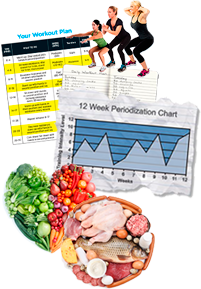
Design your workouts to grow muscle by increasing time, weight, or speed. Feed your muscle with optimal foods to fuel your workouts. Carefully design your workouts with the right schedule, intensity, type of workout, and proper exercises that progress over time. Look out for common form and exercise mistakes, and avoid falling for "toxic muscle diets" that involve binge eating foods you know are bad for you.
Building muscle is something your body is meant to do, naturally. Take the time to design a fully integrated muscle building program and you'll see results quickly.

On the other hand, if this is a lot to put together and seems a bit daunting, we'd love to do it for you. You see, Create My Workout was designed to do all the thinking for you, put workouts together automatically that progress over time, and use all of the rules you've learned today.
Besides, if you get even half the results of our other clients, you won't be sorry. Go ahead and click the button below to get started right away: (*results may vary)
